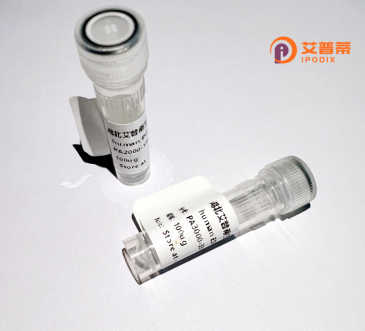
| 纯度 | >90%SDS-PAGE. |
| 种属 | Human |
| 靶点 | NR3C2 |
| Uniprot No | P08235 |
| 内毒素 | < 0.01EU/μg |
| 表达宿主 | E.coli |
| 表达区间 | 1-110 aa |
| 活性数据 | METKGYHSLPEGLDMERRWGQVSQAVERSSLGPTERTDENNYMEIVNVSCVSGAIPNNSTQGSSKEKQELLPCLQQDNNRPGILTSDIKTELESKELSATVAESMGLYMD |
| 分子量 | 37.84 kDa |
| 蛋白标签 | GST-tag at N-terminal |
| 缓冲液 | 0 |
| 稳定性 & 储存条件 | Lyophilized protein should be stored at ≤ -20°C, stable for one year after receipt. Reconstituted protein solution can be stored at 2-8°C for 2-7 days. Aliquots of reconstituted samples are stable at ≤ -20°C for 3 months. |
| 复溶 | Always centrifuge tubes before opening.Do not mix by vortex or pipetting. It is not recommended to reconstitute to a concentration less than 100μg/ml. Dissolve the lyophilized protein in distilled water. Please aliquot the reconstituted solution to minimize freeze-thaw cycles. |
以下是关于重组人NR3C2(盐皮质激素受体)蛋白的3篇参考文献概览:
---
1. **文献名称**:*Crystal structure of the human mineralocorticoid receptor DNA-binding domain complexed with a glucocorticoid response element*
**作者**:Fagart, J. et al.
**摘要**:该研究解析了重组人NR3C2蛋白DNA结合域(DBD)与糖皮质激素反应元件(GRE)结合的晶体结构,揭示了受体特异性识别DNA的分子机制,为理解盐皮质激素与糖皮质激素信号差异提供结构基础。
---
2. **文献名称**:*Ligand-induced conformational changes in the mineralocorticoid receptor*
**作者**:Bledsoe, R.K. et al.
**摘要**:通过重组人NR3C2蛋白的体外配体结合实验,分析醛固酮和拮抗剂螺内酯诱导的受体构象变化,发现配体结合可调控受体与共激活因子的相互作用,阐明了拮抗剂的作用机理。
---
3. **文献名称**:*Functional characterization of phosphorylation sites in the N-terminal domain of the human mineralocorticoid receptor*
**作者**:Shibata, S. et al.
**摘要**:研究利用重组突变体NR3C2蛋白,揭示了N端磷酸化修饰(如Ser843)对受体核转位和转录活性的关键调控作用,表明翻译后修饰影响盐皮质激素受体信号通路。
---
这些文献涵盖了结构生物学、配体相互作用及翻译后修饰等领域的研究,为NR3C2的功能与应用提供了重要参考。
The nuclear receptor subfamily 3 group C member 2 (NR3C2), also known as the mineralocorticoid receptor (MR), is a steroid-activated transcription factor belonging to the nuclear receptor superfamily. Primarily expressed in epithelial tissues (e.g., kidney, colon) and non-epithelial organs (e.g., heart, brain), it regulates electrolyte balance, blood pressure, and inflammatory responses by binding to aldosterone and cortisol. Structurally, it contains a conserved DNA-binding domain, ligand-binding domain, and activation function domain. Dysregulation of NR3C2 is implicated in hypertension, heart failure, renal fibrosis, and neuropsychiatric disorders. Recombinant human NR3C2 protein, typically produced via bacterial or mammalian expression systems, enables in vitro studies of receptor-ligand interactions, post-translational modifications, and transcriptional regulation mechanisms. Its applications include drug discovery for cardiovascular diseases and mechanistic research into tissue-specific MR signaling. Crystallography studies using recombinant NR3C2 have revealed conformational changes during agonist/antagonist binding, informing the design of selective MR modulators. Current research also explores its non-genomic signaling pathways and crosstalk with glucocorticoid receptors.
×